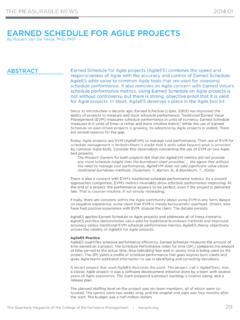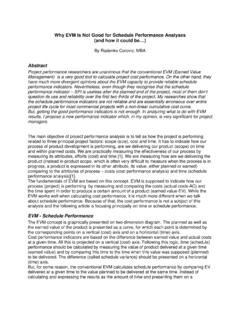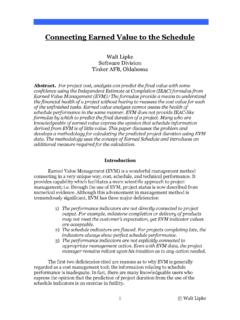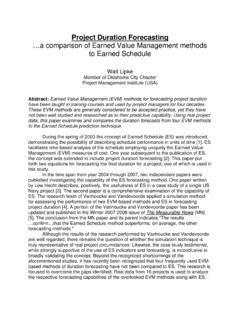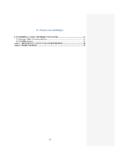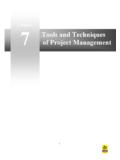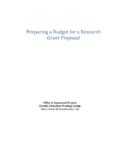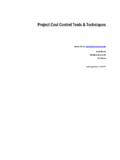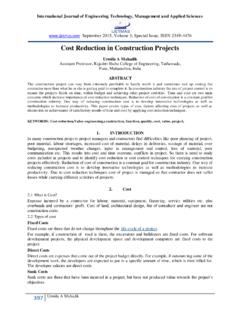Transcription of PROJECT PERFORMANCE REPORTING AND …
1 INTERNATIONAL JOURNAL OF BUSINESS AND MANAGEMENT STUDIES. Vol 3, No 1, 2011 ISSN: 1309-8047 (Online). PROJECT PERFORMANCE REPORTING AND prediction : EXTENSIONS OF EARNED VALUE MANAGEMENT. Agata Czarnigowska Lublin University of Technology, Faculty of Civil Engineering and Architecture Ul. Nadbystrzycka 40, 20-618 Lublin, Poland E-mail: Piotr Jaskowski Lublin University of Technology, Faculty of Civil Engineering and Architecture Ul. Nadbystrzycka 40, 20-618 Lublin, Poland E-mail: Slawomir Biruk Lublin University of Technology, Faculty of Civil Engineering and Architecture Ul. Nadbystrzycka 40, 20-618 Lublin, Poland E-mail: Abstract . Earned Value Management is one of the best known approaches to PROJECT progress control and REPORTING .
2 It uses information on cost, schedule and work PERFORMANCE to establish the current status of the PROJECT . By means of a few rates it allows the manager to extrapolate current trends on the PROJECT outcome. However, the method bases on a much simplified model of the PROJECT , the input is reported to be laborious to collect, and the results may be misleading. The paper outlines the basic principles of the method and discusses its recent modifications aimed at improving reliability in describing PROJECT status, expanding predictive ability, and allowing for risk control. Key Words: Earned Value, PROJECT Control, Progress REPORTING JEL Classification: M11.
3 11. INTERNATIONAL JOURNAL OF BUSINESS AND MANAGEMENT STUDIES. Vol 3, No 1, 2011 ISSN: 1309-8047 (Online). 1. INTRODUCTION. S-curves S-curves are used in PROJECT management worldwide and for nearly one hundred years: records of their practical application can be traced back to 1928. (Martyniak,2002:168). They are representation of cumulative effort related with the PROJECT plotted against time. This effort is expressed in the same units for all tasks the PROJECT comprises, usually man-hours (labour consumption) or monetary units (cost or payments). Comparing the as planned S-curve with records of actual effort, if done on regular basis, enables the manager to follow the development of the PROJECT .
4 S-curves are used both in the form of charts (to provide a one-glance insight into PROJECT PERFORMANCE ) or tables (for easy data manipulation). However, S-curves are a far going generalization of the modelled PROJECT . Interpreting them with no regard to the relationships between PROJECT tasks and reasons for deviations may lead to wrong decisions. In spite of this, S-curves do not lose on popularity in management, and one of their most common application is Earned Value a method designed to provide reliable measures of PROJECT PERFORMANCE and to allow the manager to make inferences on the final effect of the PROJECT (PMI,2005:1). Earned Value Earned Value is widely accepted as a classic management tool used for reliable progress REPORTING and process control.
5 It is the core of management systems used by many public and government organisations, especially in English-speaking countries (DOD,1997) (DOE,2008), and is described by numerous national standards, (AS,2006) (ANSI,1998). The idea of Earned Value consists in constructing a baseline, against which actual progress will be checked; the baseline is Budgeted Cost of Works Scheduled (BCWS) the S-curve of cumulative planned costs, shown against planned time of their incurrence (Figure 1). BCWS is based on the budget broken down into manageable, clearly defined tasks. At completion (T), the value of BCWS equals the total planned cost of the whole PROJECT , Budget at Completion (BAC).
6 As the PROJECT starts, careful monitoring of actual task progress and task cost is being made on regular basis. Two more S-curves are produced (PMI,2005:8). Budgeted Cost of Work Performed (BCWP) the sum of as-planned cost of tasks actually done up to the moment of PERFORMANCE check; compared with the baseline, BCWS, it serves as a measure of physical progress of works;. 12. INTERNATIONAL JOURNAL OF BUSINESS AND MANAGEMENT STUDIES. Vol 3, No 1, 2011 ISSN: 1309-8047 (Online). Actual Cost of Work Performed (ACWP) the sum of incurred cost of works actually done up to the moment of PERFORMANCE check; compared with BCWP (as it concerns actually completed works, not as-planned works as BCWS) will provide information on deviation from the budget.
7 The input having been collected, PROJECT status indicators can be calculated and current PROJECT development tendencies can be extrapolated to give the manager the prospects of possible final effect of the PROJECT . The idea is illustrated by an example in figure 1. Figure-1: Earned Value curves; the PROJECT is currently (at week 10) over budget and behind schedule Percent Complete (PC) is the level of scope completion at the moment of progress check, a figure that may be particularly useful in REPORTING : BCWP. PC = . BAC. Cost Variance (CV) is a measure of deviation between the budgeted and the actual cost of works actually completed up to the date of progress check, expresses in monetary units.
8 If negative, it indicates that the PROJECT is over budget: CV = BCWP ACWP . Cost PERFORMANCE Index (CPI) also compares the planned and actual value of works done. As a relative measure, it is more informative than CV in terms of the scale of deviation from the budget. If less than 1, it indicates that the PROJECT has consumed more money than planned: 13. INTERNATIONAL JOURNAL OF BUSINESS AND MANAGEMENT STUDIES. Vol 3, No 1, 2011 ISSN: 1309-8047 (Online). BCWP. CPI = . ACWP. Schedule Variance (SV), though expressed in monetary units, is considered to be the measure of deviation between the actual physical progress of works and their planned progress.
9 It is the difference between the planned cost of work completed and planned cost of work that should have been done by the REPORTING date. If negative, it indicates a delay: SV = BCWP BCWS . Like CV, the PROJECT 's SV is a sum of SVs of particular tasks, so if there are some tasks delayed and some tasks accelerated, SV may show no deviation at all. The model is too simple to distinguish between critical and non-critical tasks. Schedule PERFORMANCE Index (SPI) compares the planned cost of work done with planned cost of work scheduled. SPI less than 1 indicates a delay: BCWP. SPI = . BCWS. EAC Estimate at Completion is an estimate of the effect of deviations accumulated from the PROJECT 's start on the total PROJECT cost.
10 Several formulas are used (PMI 2005:21) (Christensen 1994:17), but one of the most common is based on the PROJECT 's CPI at the date of PERFORMANCE check (PMI 2005:20): BAC. EAC = . CPI. A similar rough estimate of the total time required to complete the PROJECT , T'. can be made using SPI and the as-planned duration T but, as S-curves do not reflect relationships between tasks and SPI bases on deviations in terms on cost, not time, such estimate cannot be considered reliable (PMI 2005:17): T. T'= . SPI. 3. Improvements of the method General overview There are some serious drawbacks resulting from the fact of reducing a complex system of a PROJECT to an extremely simplified, two-dimensional S-curve model.

